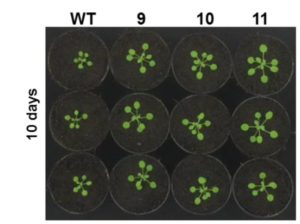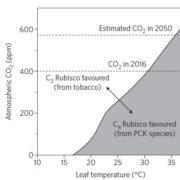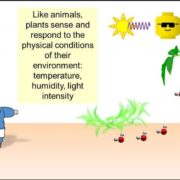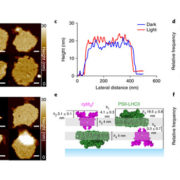Enhancing Electron Transport Leads to Improved Yields
 Increasing photosynthetic capacity appears to be a viable route towards increasing crop yields. An endogenous target identified for manipulation toward this goal is the cytochrome b6f (cyt b6f) complex that is located in the thylakoid membrane and which functions in both linear and cyclic electron transport, providing ATP and NADPH for photosynthetic carbon fixation. Studies involving inhibitors of cyt b6f inhibitors as well as studies examining transgenic reductions in the levels of the Rieske FeS protein, a component of the cyt b6f complex, have demonstrated that the activity of the cyt b6f complex is a key determinant of the rate of electron transport. However, being a membrane localized, multiprotein complex that it is composed of eight different subunits, six being encoded in the chloroplast genome and two in the nucleus, cyt b6f is extraordinarily complex, tinkering with the cyt b6f structure seems a daunting task. Notwithstanding the genetic and structural complexity of the cyt b6f complex, however, it has previously been shown that it is possible to manipulate the levels of the cyt b6f complex by down regulation of the expression of the Rieske FeS protein. It has also been shown that the Rieske FeS protein is one of the subunits required for the successful assembly of the cyt b6f complex. Based on these findings, Simkin et al. () reasoned that the over-expression of the Rieske FeS protein might be a feasible approach towards increasing electron flow through the cyt b6f complex. Using transgenic Arabidopsis (Arabidopsis thaliana) with increased levels of the Rieske FeS protein, the authors demonstrate that this manipulation resulted in an increase in photosynthetic electron transport, CO2 assimilation and yield. This work provides evidence that the process of electron transport is potential route for improving plant productivity.
Increasing photosynthetic capacity appears to be a viable route towards increasing crop yields. An endogenous target identified for manipulation toward this goal is the cytochrome b6f (cyt b6f) complex that is located in the thylakoid membrane and which functions in both linear and cyclic electron transport, providing ATP and NADPH for photosynthetic carbon fixation. Studies involving inhibitors of cyt b6f inhibitors as well as studies examining transgenic reductions in the levels of the Rieske FeS protein, a component of the cyt b6f complex, have demonstrated that the activity of the cyt b6f complex is a key determinant of the rate of electron transport. However, being a membrane localized, multiprotein complex that it is composed of eight different subunits, six being encoded in the chloroplast genome and two in the nucleus, cyt b6f is extraordinarily complex, tinkering with the cyt b6f structure seems a daunting task. Notwithstanding the genetic and structural complexity of the cyt b6f complex, however, it has previously been shown that it is possible to manipulate the levels of the cyt b6f complex by down regulation of the expression of the Rieske FeS protein. It has also been shown that the Rieske FeS protein is one of the subunits required for the successful assembly of the cyt b6f complex. Based on these findings, Simkin et al. () reasoned that the over-expression of the Rieske FeS protein might be a feasible approach towards increasing electron flow through the cyt b6f complex. Using transgenic Arabidopsis (Arabidopsis thaliana) with increased levels of the Rieske FeS protein, the authors demonstrate that this manipulation resulted in an increase in photosynthetic electron transport, CO2 assimilation and yield. This work provides evidence that the process of electron transport is potential route for improving plant productivity.










Leave a Reply
Want to join the discussion?Feel free to contribute!